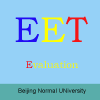-
Computer Adaptive Testing
普通类 -
- 支持
- 批判
- 提问
- 解释
- 补充
- 删除
-
-
Computer Adaptive Testing
A COMPUTER ADAPTIVE TEST (CAT) IS AN automated assessment in which all examinees begin at a common starting question, but their individual responses then determine which questions each student sees next. CATs provide many advantages over traditional testing methods, but some disadvantages as well. These will be discussed within the context of K-12 education.-
Advantages
This adaptive approach to testing is designed to ensure that each student sees questions that are close to their true ability level. Questions that are too difficult or too easy provide no knowledge about a student's knowledge and are, therefore, never seen by any student. The frustration that accompanies questions of this type is removed from the CAT experience as the student test taker creates their path through the test.
This animation illustrates student paths through a CAT. Different students will answer different questions based on their ability level.
Another benefit of the adaptive approach is reduced student test times. Since students are not required to answer all test questions within a given booklet, less time is spent out of the classroom. The disruption that accompanies a traditional testing process is minimized.
There are no answer sheets to collect and mail back to the testing company. Test scoring is automated and reporting is immediate. Student deficiencies and strengths are quickly identified and can be addressed or developed respectively, in time to make a difference during the current school year.
With the advancement in computer technology, CATs can be delivered to a school site over the Internet. Remote locations across the country or the world can be serviced from a single test server location with equal ease.
Remote school sites have equal access to a CAT delivered over the Internet.-
Disadvantages
The main disadvantage of the CAT is linked to it's complete dependence on technology. If a school site is not connected to the Internet, for example, it may not be able to access test questions at all.
Schools that do not have computer labs will not be able to assess large numbers of students easily. This is not an issue with traditional paper-and-pencil tests which can be administered in any classroom.
Students lack of familiarity with computers and their operation may also be a limiting factor, especially for younger students. This could increase measurement error and effect the overall reliability of the CAT.
CATs are not designed to deal with open-ended questions. Anything outside of the multiple-choice or true/false format needs to be handled with an alternative type of assessment.-
Conclusion
CATs have noteworthy advantages over their paper-and-pencil predecessors. As potential disadvantages are overcome, it is conceivable that the CAT could become the assessment method of choice among school districts.-
Author
Jason Chrest
Graduate Student
San Diego State University -
-
- 标签:
- adaptive
- computer
- cats
- advantages
- test
- student
- school
- disadvantages
- testing
- cat
- questions
- students
-
加入的知识群:



学习元评论 (0条)
聪明如你,不妨在这 发表你的看法与心得 ~